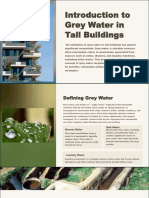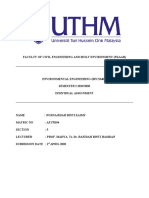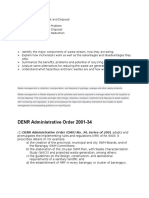0 ratings0% found this document useful (0 votes)
24 views5 R-Reduce, Reuse, Recycle, Refuse, Recover
5 R-Reduce, Reuse, Recycle, Refuse, Recover
Uploaded by
Angelie LapeThis document discusses the 5 R's of reducing waste - refuse, reduce, reuse, recycle, and recover. It focuses on recycling and reusing water. Recycled water is treated wastewater that can be used for irrigation, industrial processes, and replenishing groundwater. Greywater from bathing and laundry can be reused for outdoor uses like landscaping after treatment, while blackwater from toilets requires further treatment before reuse indoors. Reusing water provides benefits like conserving water resources and reducing pollution. Proper treatment and maintenance is needed to address issues like pathogens. Industries can also reduce wastewater by analyzing processes, prevention programs, and proper treatment technologies. Materials like water, energy, and
Copyright:
© All Rights Reserved
Available Formats
Download as DOCX, PDF, TXT or read online from Scribd
5 R-Reduce, Reuse, Recycle, Refuse, Recover
5 R-Reduce, Reuse, Recycle, Refuse, Recover
Uploaded by
Angelie Lape0 ratings0% found this document useful (0 votes)
24 views2 pagesThis document discusses the 5 R's of reducing waste - refuse, reduce, reuse, recycle, and recover. It focuses on recycling and reusing water. Recycled water is treated wastewater that can be used for irrigation, industrial processes, and replenishing groundwater. Greywater from bathing and laundry can be reused for outdoor uses like landscaping after treatment, while blackwater from toilets requires further treatment before reuse indoors. Reusing water provides benefits like conserving water resources and reducing pollution. Proper treatment and maintenance is needed to address issues like pathogens. Industries can also reduce wastewater by analyzing processes, prevention programs, and proper treatment technologies. Materials like water, energy, and
Original Description:
Intro to Envi. Mgt.
Original Title
5 R
Copyright
© © All Rights Reserved
Available Formats
DOCX, PDF, TXT or read online from Scribd
Share this document
Did you find this document useful?
Is this content inappropriate?
This document discusses the 5 R's of reducing waste - refuse, reduce, reuse, recycle, and recover. It focuses on recycling and reusing water. Recycled water is treated wastewater that can be used for irrigation, industrial processes, and replenishing groundwater. Greywater from bathing and laundry can be reused for outdoor uses like landscaping after treatment, while blackwater from toilets requires further treatment before reuse indoors. Reusing water provides benefits like conserving water resources and reducing pollution. Proper treatment and maintenance is needed to address issues like pathogens. Industries can also reduce wastewater by analyzing processes, prevention programs, and proper treatment technologies. Materials like water, energy, and
Copyright:
© All Rights Reserved
Available Formats
Download as DOCX, PDF, TXT or read online from Scribd
Download as docx, pdf, or txt
0 ratings0% found this document useful (0 votes)
24 views2 pages5 R-Reduce, Reuse, Recycle, Refuse, Recover
5 R-Reduce, Reuse, Recycle, Refuse, Recover
Uploaded by
Angelie LapeThis document discusses the 5 R's of reducing waste - refuse, reduce, reuse, recycle, and recover. It focuses on recycling and reusing water. Recycled water is treated wastewater that can be used for irrigation, industrial processes, and replenishing groundwater. Greywater from bathing and laundry can be reused for outdoor uses like landscaping after treatment, while blackwater from toilets requires further treatment before reuse indoors. Reusing water provides benefits like conserving water resources and reducing pollution. Proper treatment and maintenance is needed to address issues like pathogens. Industries can also reduce wastewater by analyzing processes, prevention programs, and proper treatment technologies. Materials like water, energy, and
Copyright:
© All Rights Reserved
Available Formats
Download as DOCX, PDF, TXT or read online from Scribd
Download as docx, pdf, or txt
You are on page 1of 2
5 R- Reduce, Reuse, Recycle, Refuse, Recover
1. 1. REFUSE, REDUCE, RECYCLE, REUSE, RECOVERY Akash Tikhe
akashtk92@gmail.com
2. 2. RECYCLING Recycled water, is former wastewater that is treated to remove solids and
certain impurities, and used in sustainable landscaping irrigation or to recharge groundwater
aquifers. Recycled water can be use for agricultural and landscape irrigation, industrial
processes, toilet flushing, and to recharge ground water basins.
3. 3. USE OF RECYCLED WATER Agriculture Landscape Public parks Golf course
irrigation Cooling water for power plants and oil refineries Processing water for mills,
plants Toilet flushing Dust control Construction activities Concrete mixing Artificial
lakes
4. 4. REUSE Water reuse describes the process whereby wastewater treated to an
appropriate standard, is reused for a variety of beneficial purposes. The treated water ready
to be reused is termed recycled or reclaimed water.
5. 5. TYPE OF WASTEWATER FOR REUSE Greywater Bathroom, washbasin, laundry, kitchen
waste Blackwater Toilet flushing toilet flushing clothes washing gardening suitable only for
outdoor use i.e. groundwater recharge, fountains
6. 6. REUSE OF GREYWATER
7. 7. GREYWATER TREATMENT The treatment may be biological, chemical or mechanical.
The qualities of treated water they produce can vary considerably, as well as their energy
consumption and initial cost.
8. 8. DISINFECTION Disinfection is required for indoor re-use of greywater, which requires
regular maintenance. Chlorine is most commonly used for disinfection. However, it has
adverse environmental impacts. Alternatives disinfectant can be ultraviolet (UV) or ozone.
9. 9. RELIANCE PETROLEUM LIMITED, JAMNAGAR Wastewater Reclamation Plant
(capacity=48,000 m/d) LTDS (oily condensates & contaminated storm waters) TDS <500
mg/l Chloride <300 mg/l HTDS (oily wastewater & contains dissolved salts such as NaCI,
neutralized spent caustic and contaminated cooling water TDS 1000 to 2000 mg/l cooling
tower for local green belt development irrigation Cooling tower Primary treatment API-
separator and dissolved air flotation for oil removal ASP & Biotowers with plastic packings
Dual media FiltersGranular Activated Carbon Biological treatment Tertiary FiltrationAdvance
treatment Effluent Treatment Plant
10. 10. ADVANTAGES Use less water resources. Irrigate your gardens during drought water
restrictions. Cut down the amount of pollution going into our waterways. Help save
money on new infrastructure for water provision and wastewater treatment.
11. 11. ISSUES Reusing greywater for washing clothes may cause discoloration of clothing
due to dissolved organic material. This can be avoided by installing an activated carbon filter.
It cannot be stored untreated for longer than a few hours as it begins to turn septic and
smell. It can contain significant numbers of pathogens which spread disease. The mode
of living in home i.e. holiday home that have intermittent use
12. 12. ISSUES Seasonal variation in generation of wastewater In order to re-use greywater
indoors for toilet flushing and clothes washing you will need to firstly: Separate greywater
and blackwater waste streams. Install a greywater treatment and disinfection Financial
cost of installing and maintaining a re-use system
13. 13. REDUCE Take a short shower Use appropriate shower head Wash full load for
laundry Regular maintenance and repairing of water leakages Choose recycled product
Avoid using dishwasher Water the lawn early in the morning Avoid using running tap in
wash basin while brushing and shaving Avoid unnecessary flushing
14. 14. REDUCTION OF WASTEWATER IN INDUSTRIES Key steps of Wastewater
Management Step 1: Analyze manufacturing processes; gain an understanding of how
wastewater is produced. Step 2: Develop a pollution prevention program based on the gained
knowledge from analyzing the manufacturing process. Step 3: Choice of candidate treatment
technology for proper process control and waste minimization.
15. 15. WHAT CAN WE RECOVER FROM WASTEWATER? Water Reuse Bio-Energy Salts
((Organic) Fertilizer
16. 16. THANK YOU
You might also like
- Waste Water TreatmentDocument22 pagesWaste Water TreatmentJose Gabriel Delos Santos100% (2)
- How Industrial Businesses Can Reduce Production Costs With Reverse Osmosis: Industrial Reverse OsmosisFrom EverandHow Industrial Businesses Can Reduce Production Costs With Reverse Osmosis: Industrial Reverse OsmosisRating: 5 out of 5 stars5/5 (1)
- Obligations and Contracts FlashcardsDocument7 pagesObligations and Contracts FlashcardsAngelie Lape100% (1)
- 6.water RecyclingDocument8 pages6.water RecyclingmariyaNo ratings yet
- Water ReuseDocument12 pagesWater ReuseKiata WayuyabNo ratings yet
- Indicator 6.3.1Document9 pagesIndicator 6.3.1Mishika MalikNo ratings yet
- Water Conservation: by Ouseph Joy (7225) Binnu Jacob (7141)Document30 pagesWater Conservation: by Ouseph Joy (7225) Binnu Jacob (7141)ousephNo ratings yet
- Iwwt BDocument2 pagesIwwt BBalvinder SinghNo ratings yet
- Waste Water TreatmentDocument7 pagesWaste Water Treatmentmostafa HusseinNo ratings yet
- Weo Water Treatment and ReuseDocument4 pagesWeo Water Treatment and ReuseWendyNo ratings yet
- SeminarDocument9 pagesSeminarNikita BhagatNo ratings yet
- DesalinationDocument28 pagesDesalinationكمونه عاطفNo ratings yet
- RayterDocument4 pagesRayterLTE002No ratings yet
- Design of Sewage Treatment Plant With Uasb TechnologyDocument64 pagesDesign of Sewage Treatment Plant With Uasb TechnologyMohd Javeed0% (1)
- Water Solutions ProfileDocument13 pagesWater Solutions ProfileGanesh VijaykumarNo ratings yet
- Module 10 - (L38 - L40) : " I Li "Water Conservation & RecyclingDocument36 pagesModule 10 - (L38 - L40) : " I Li "Water Conservation & Recyclingsivaram619No ratings yet
- Gray Water & Rainwater HarwestingDocument21 pagesGray Water & Rainwater HarwestingARCHITECT77No ratings yet
- I. Volume Reduction:: A. Classification of WastesDocument5 pagesI. Volume Reduction:: A. Classification of WastesvijaykrishnaasacivilNo ratings yet
- Waste WaterDocument60 pagesWaste Waterbarhooom100% (1)
- Refining WaterDocument60 pagesRefining WaterSohail MalikNo ratings yet
- Aditya KanawadeDocument11 pagesAditya Kanawadesanketpatil762067No ratings yet
- Iwm L 8Document41 pagesIwm L 8Aditya SutarNo ratings yet
- Waste Water TreatmentDocument117 pagesWaste Water TreatmentJalaj Sharma100% (1)
- Water Conservation: From Wikipedia, The Free EncyclopediaDocument6 pagesWater Conservation: From Wikipedia, The Free Encyclopediamanish_pareek_1No ratings yet
- Water Treatment FacilitiesDocument9 pagesWater Treatment FacilitiesJackie BeltranNo ratings yet
- RAINWATER HARVESTING ReviewerDocument4 pagesRAINWATER HARVESTING ReviewerMildea Gabuya RabangNo ratings yet
- Eco Friendly Textiles - PART-IIDocument57 pagesEco Friendly Textiles - PART-IISangeethapriya AvinutyNo ratings yet
- Catalog HyfluxDocument12 pagesCatalog HyfluxfatraskyNo ratings yet
- Imp Distillery Industry Wastewater TreatmentDocument21 pagesImp Distillery Industry Wastewater Treatmentteddybir100% (1)
- Modern Effluent Treatment Plant PDFDocument6 pagesModern Effluent Treatment Plant PDFLuu TonyNo ratings yet
- Waste Reduction Alternatives (Volume Reduction)Document4 pagesWaste Reduction Alternatives (Volume Reduction)Abhishek AryaNo ratings yet
- CES ProfileDocument12 pagesCES ProfileGanesh VijaykumarNo ratings yet
- Bec Biodigester LatestDocument42 pagesBec Biodigester LatestRahul Ravi SinghNo ratings yet
- Water ReduceDocument5 pagesWater Reducekrishna.greenhrNo ratings yet
- Plumbing 19Document4 pagesPlumbing 19kasandra01No ratings yet
- Waste & Waste Water Recycling: C2.2 Ecology & Sustainable HabitatDocument50 pagesWaste & Waste Water Recycling: C2.2 Ecology & Sustainable HabitatTarakesh BnNo ratings yet
- 5 IntroDocument4 pages5 Intropriya12mishra2003No ratings yet
- Water ConservationDocument18 pagesWater ConservationKhiZra ShahZad100% (2)
- Save Water Presentation 2023Document80 pagesSave Water Presentation 2023Mehdi AcilNo ratings yet
- Basic Tutorial - Wastewater Management - Shiv Shankar Ranganathan PDFDocument2 pagesBasic Tutorial - Wastewater Management - Shiv Shankar Ranganathan PDFAditya MaheshwariNo ratings yet
- Car WashingDocument51 pagesCar WashingShiv Anand0% (1)
- Industrial Water and Waste Water ManagementDocument15 pagesIndustrial Water and Waste Water ManagementsagarNo ratings yet
- WASTE WATER TREATMENT PLANT REPORT Final-1Document16 pagesWASTE WATER TREATMENT PLANT REPORT Final-1clan21114No ratings yet
- Agricultural Applications: Wastewater - ReuseDocument2 pagesAgricultural Applications: Wastewater - ReuseSanctaTiffanyNo ratings yet
- Waste Management Systems-Unit 1 & 2Document15 pagesWaste Management Systems-Unit 1 & 2Ravi Shankar KolluruNo ratings yet
- Water Treatment - WikipediaDocument8 pagesWater Treatment - Wikipediaramthecharm_46098467No ratings yet
- Produced Water TreatmentDocument53 pagesProduced Water Treatmenttomjones77100% (1)
- 1.1 Objective of The StudyDocument13 pages1.1 Objective of The StudyRanNo ratings yet
- CCWTLDocument20 pagesCCWTLHardikNo ratings yet
- Submitted To-Jatinder Singh Submitted by - Harsimran KaurDocument11 pagesSubmitted To-Jatinder Singh Submitted by - Harsimran KaurBobby SinghNo ratings yet
- Shambhunath Institute of Engineering and Technology AllahabadDocument20 pagesShambhunath Institute of Engineering and Technology AllahabadabhishekNo ratings yet
- T Have Water Problem But Water DistributionDocument5 pagesT Have Water Problem But Water Distributiongeo.i.consultancy.casNo ratings yet
- Water Treatment and Wastewater TreatmentDocument6 pagesWater Treatment and Wastewater Treatmentalisa naziraNo ratings yet
- Treatment For Drinking Water ProductionDocument13 pagesTreatment For Drinking Water ProductionmanjunathNo ratings yet
- Reed Water Bed by PSDADocument11 pagesReed Water Bed by PSDAMohammed AsifNo ratings yet
- Water ConservationDocument3 pagesWater ConservationAbha MalikNo ratings yet
- How Reverse Osmosis Works: A Look at Industrial ROFrom EverandHow Reverse Osmosis Works: A Look at Industrial RORating: 2.5 out of 5 stars2.5/5 (2)
- Rainwater Harvesting: Understanding the Basics of Rainwater Harvesting (Transform Your Home and Farm With Rainwater to Uncover Self-sufficiency Secrets)From EverandRainwater Harvesting: Understanding the Basics of Rainwater Harvesting (Transform Your Home and Farm With Rainwater to Uncover Self-sufficiency Secrets)No ratings yet
- Eco-Friendly Plumbing Solutions: Sustainable Practices and Innovative Technologies for the Green Homeowner: Homeowner Plumbing Help, #5From EverandEco-Friendly Plumbing Solutions: Sustainable Practices and Innovative Technologies for the Green Homeowner: Homeowner Plumbing Help, #5No ratings yet
- Making Suburbs Sustainable1Document4 pagesMaking Suburbs Sustainable1Angelie LapeNo ratings yet
- Land Tenure, Land Management and Land Information SystemsDocument27 pagesLand Tenure, Land Management and Land Information SystemsAngelie LapeNo ratings yet
- CHAPTER 4. Land Information Systems: Services and Tools of Public Land AdministrationDocument8 pagesCHAPTER 4. Land Information Systems: Services and Tools of Public Land AdministrationAngelie LapeNo ratings yet
- The Origin of Urban Sprawl1Document50 pagesThe Origin of Urban Sprawl1Angelie LapeNo ratings yet
- Water Management1Document22 pagesWater Management1Angelie Lape100% (1)
- Air Pollution v.2Document36 pagesAir Pollution v.2Angelie LapeNo ratings yet
- Making Suburbs SustainableDocument4 pagesMaking Suburbs SustainableAngelie LapeNo ratings yet
- Atmosphere: BY: Group 10Document36 pagesAtmosphere: BY: Group 10Angelie LapeNo ratings yet
- Follow The Waste StreamDocument1 pageFollow The Waste StreamAngelie LapeNo ratings yet
- Finals Report IntroDocument1 pageFinals Report IntroAngelie LapeNo ratings yet
- Air PollutionDocument10 pagesAir PollutionAngelie LapeNo ratings yet
- Solid Waste Management and DisposalDocument68 pagesSolid Waste Management and DisposalAngelie Lape100% (1)
- Renewable Energy Poster PDFDocument1 pageRenewable Energy Poster PDFAngelie LapeNo ratings yet
- Difference Between Grouped and Ungrouped DataDocument3 pagesDifference Between Grouped and Ungrouped DataAngelie Lape67% (3)
- The Aquatic BiomeDocument4 pagesThe Aquatic BiomeAngelie LapeNo ratings yet
- Fire SafetyDocument8 pagesFire Safetyrahmanhse22No ratings yet
- DX700Document3 pagesDX700Alonzo Medina FloresNo ratings yet
- SWORD Blade LengthDocument24 pagesSWORD Blade LengthnaZar100% (1)
- Structure Types: Monatomic Simple Molecular Giant Covalent Ionic MetallicDocument1 pageStructure Types: Monatomic Simple Molecular Giant Covalent Ionic MetallicZack CurryNo ratings yet
- Synthetic Antibacterial AgentsDocument58 pagesSynthetic Antibacterial AgentsApurba Sarker Apu100% (3)
- Dbdid 9akk101130d7748Document2 pagesDbdid 9akk101130d7748AbomhNo ratings yet
- Reactive Processing of Textile Fiber-Reinforced Thermoplastic Composites - An OverviewDocument16 pagesReactive Processing of Textile Fiber-Reinforced Thermoplastic Composites - An OverviewabiliovieiraNo ratings yet
- Flame Photometry of Na & KDocument2 pagesFlame Photometry of Na & KPeter MuiaNo ratings yet
- Deoxaluminite Primer, 155-00: Johnson Manufacturing Company Safety Data SheetDocument4 pagesDeoxaluminite Primer, 155-00: Johnson Manufacturing Company Safety Data SheetAvishek GuptaNo ratings yet
- Safety Data Sheet: Section 1. IdentificationDocument7 pagesSafety Data Sheet: Section 1. IdentificationArash AbbasiNo ratings yet
- p4 Classified Topics 1,2,3,4Document79 pagesp4 Classified Topics 1,2,3,4Abdullah Mostafa100% (2)
- 1-S2.0-0008884687900123-Main - Pdf-Ho and Lewis PDFDocument16 pages1-S2.0-0008884687900123-Main - Pdf-Ho and Lewis PDFPriscilla CordeiroNo ratings yet
- Lecture HAZOP ExampleDocument29 pagesLecture HAZOP ExampleIbtida SultanaNo ratings yet
- 5 Building Items 2004-05Document29 pages5 Building Items 2004-05sclbscplNo ratings yet
- BIO101 Lec 04-DNA Denaturation and RenaturationDocument29 pagesBIO101 Lec 04-DNA Denaturation and RenaturationMika MaravillaNo ratings yet
- Why Perlite WorksDocument2 pagesWhy Perlite WorksBayu SayektiNo ratings yet
- List Perusahaan Petrochemical Dan EnergyDocument2 pagesList Perusahaan Petrochemical Dan EnergyAditya Damar JatiNo ratings yet
- Heat ConductionDocument4 pagesHeat ConductionImtiaz Alam0% (1)
- Pipeliner® NR®-208-XP: (Applies Only To U.S. Products)Document2 pagesPipeliner® NR®-208-XP: (Applies Only To U.S. Products)Pablo PazNo ratings yet
- Potassium HumateDocument7 pagesPotassium HumateAnonymous Wc69e8wpnNo ratings yet
- SKKT 323-12eDocument4 pagesSKKT 323-12eParvezNo ratings yet
- Chemistry Model PaperDocument31 pagesChemistry Model PaperShimon JosephNo ratings yet
- AnnexD.2 CertificationOfServiceDeliverySupport (Medicines)Document3 pagesAnnexD.2 CertificationOfServiceDeliverySupport (Medicines)Josanne Wadwadan De CastroNo ratings yet
- Chapter 4Document62 pagesChapter 4Eva NatashaNo ratings yet
- Methods of SeparationDocument2 pagesMethods of SeparationAjay LakshmananNo ratings yet
- Finalexam RevDocument6 pagesFinalexam RevHuấnĐìnhNguyễnNo ratings yet
- Hayward MVA-06 - 7.22.13Document60 pagesHayward MVA-06 - 7.22.13salalahNo ratings yet
- Design Pressure in kg/cm2: 19.9Document4 pagesDesign Pressure in kg/cm2: 19.9jokishNo ratings yet
- Zongping Shao, Xiaomin Xu - Zinc-Air Batteries - Introduction, Design Principles and Emerging Technologies-Wiley-VCH (2022)Document295 pagesZongping Shao, Xiaomin Xu - Zinc-Air Batteries - Introduction, Design Principles and Emerging Technologies-Wiley-VCH (2022)Martin EkiyorNo ratings yet
- Title: Centrifugation Objective:: 1605608 Siau Siew ChingDocument5 pagesTitle: Centrifugation Objective:: 1605608 Siau Siew ChingXiuQingNo ratings yet









































































































